Kilimanjaro weather can generally be divided into 'wet and dry' months instead of seasons. This is because Mount Kilimanjaro is situated in the tropics and is such a large geographic structure that it essentially creates its own weather.
Weather and temperatures on Kilimanjaro vary significantly by day and night, and by altitude.
Hikers need to be prepared for big changes in temperature throughout the day, and as they trek higher. This is why layering is so important (see my guide to Kilimanjaro gear and specifically clothing for Kilimanjaro).
In this article I've provided a handy month-by-month guide to weather on Kilimanjaro as well outlined historical weather patterns for each of Kilimanjaro’s climatic zones.
You will also find weekly forecasts and Kilimanjaro summit temperature info.
My Quick Takeaways
Planning to climb Mount Kilimanjaro? Here's a quick overview of the Kilimanjaro weather conditions you can expect:
- January to March: This period marks the short dry season. While conditions are generally dry, temperatures are colder, especially at higher elevations, with a higher likelihood of snow near the summit. The trails are less crowded during these months.
- April to May: These are the long rainy months, characterized by heavy rainfall, particularly on the mountain's lower slopes. The trails can become slippery and visibility is often reduced due to cloud cover. It's generally not recommended to trek during this period.
- June to September: This is the long dry season and the most popular time for trekking. The weather is generally stable, with clear skies and warmer temperatures during the day. However, due to its popularity, the trails can be quite busy.
- October: A shoulder month with relatively good weather conditions. The trails are less crowded, making it a favorable time for those seeking a quieter experience.
- November: Known as the short rainy season, November brings lighter rains compared to April and May. The northern routes, such as the Rongai Route, tend to be drier during this time, offering a viable option for trekkers.
- December: Conditions are colder, especially at higher elevations, with a higher chance of encountering snow. Despite the chill, many trekkers opt for a December climb to experience a summit during the festive season.
Temperatures on Kilimanjaro vary significantly with altitude. At the base, temperatures can be quite warm, but as you ascend, especially above 4,000 meters, temperatures can drop below freezing, particularly during the night.
Ready to learn more about the Kilimanjaro weather? Let's get into it.
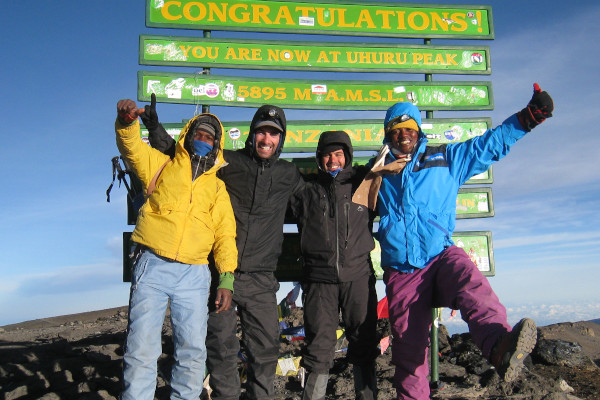
Get a Kilimanjaro trek quote
These are the companies I recommend...
Mt Kilimanjaro Weather by Month
What is the weather like on Kilimanjaro in January and February?
January and February is the first "short dry season" on Mount Kilimanjaro, making it a great time to trek.
This time of the year tends to be colder than the longer dry season of June-September and you have a higher chance of encountering snow on the upper reaches of Mount Kilimanjaro.
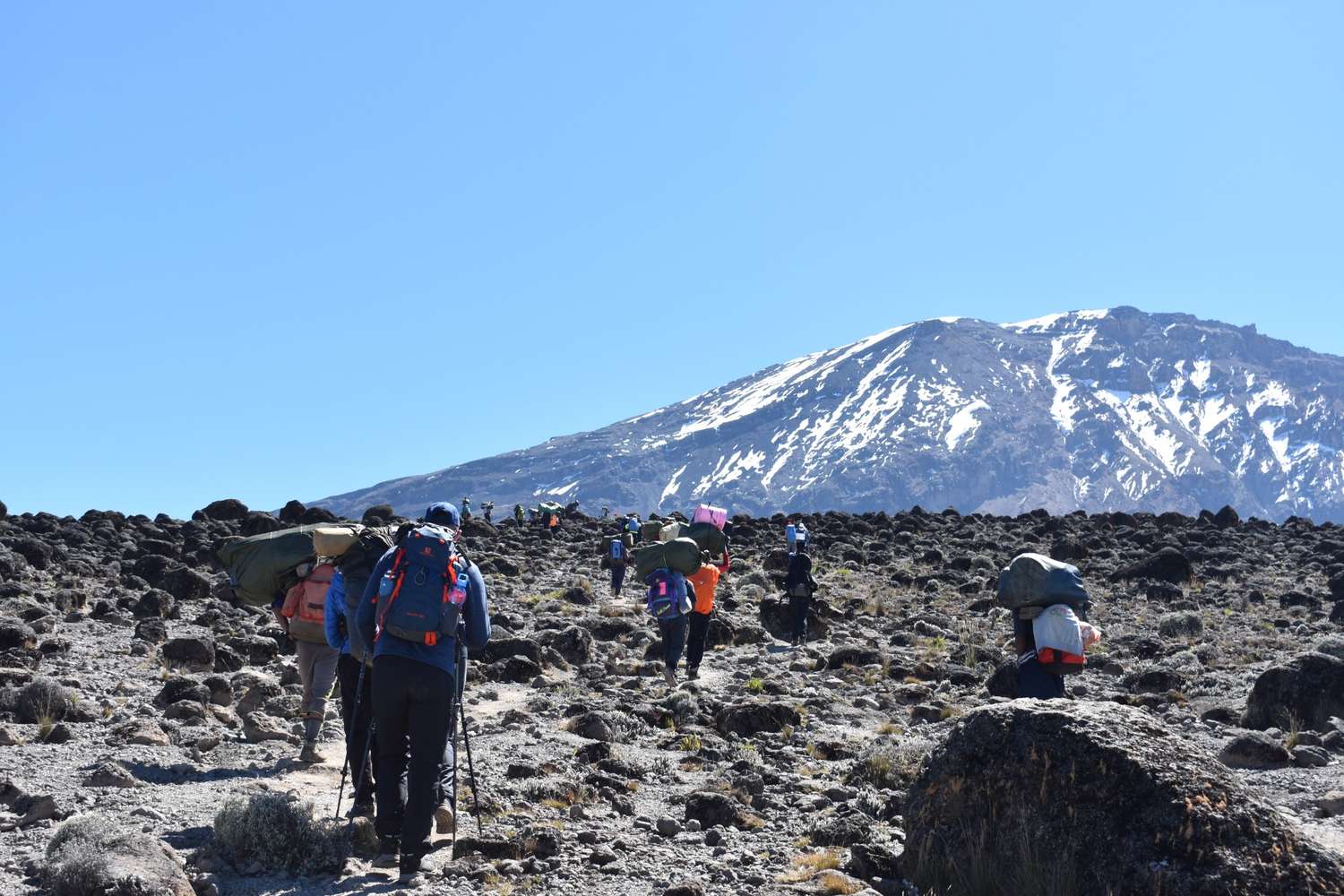
A beautiful, clear morning trekking between Shira Camp and Lava Tower (Feb 2024). The days were mostly clear with some cloud cover usually coming over around noon.
It's worth mentioning that the wind during my last summit in February was very strong at the higher camps and became gale force at Base Camp and up to Stella Point.
Many trekkers turned back from their summit attempt due to these extreme winds which also blast dust into your face and irritates the eyes.
My Pro Tip: Personally, I'd recommend taking a pair of safety goggles with. Goggles are not on any Kilimanjaro kit list and there's an 80% chance you won't need them; but you'll be grateful to have them if you do!
What is the weather like on Kilimanjaro in March?
March on Kilimanjaro is a shoulder month in the trekking season. Towards the end of March you can feel more moisture in the air and encountering rain is more likely.
However, the slopes are generally quite quiet, making early March a good time to hike Kilimanjaro.
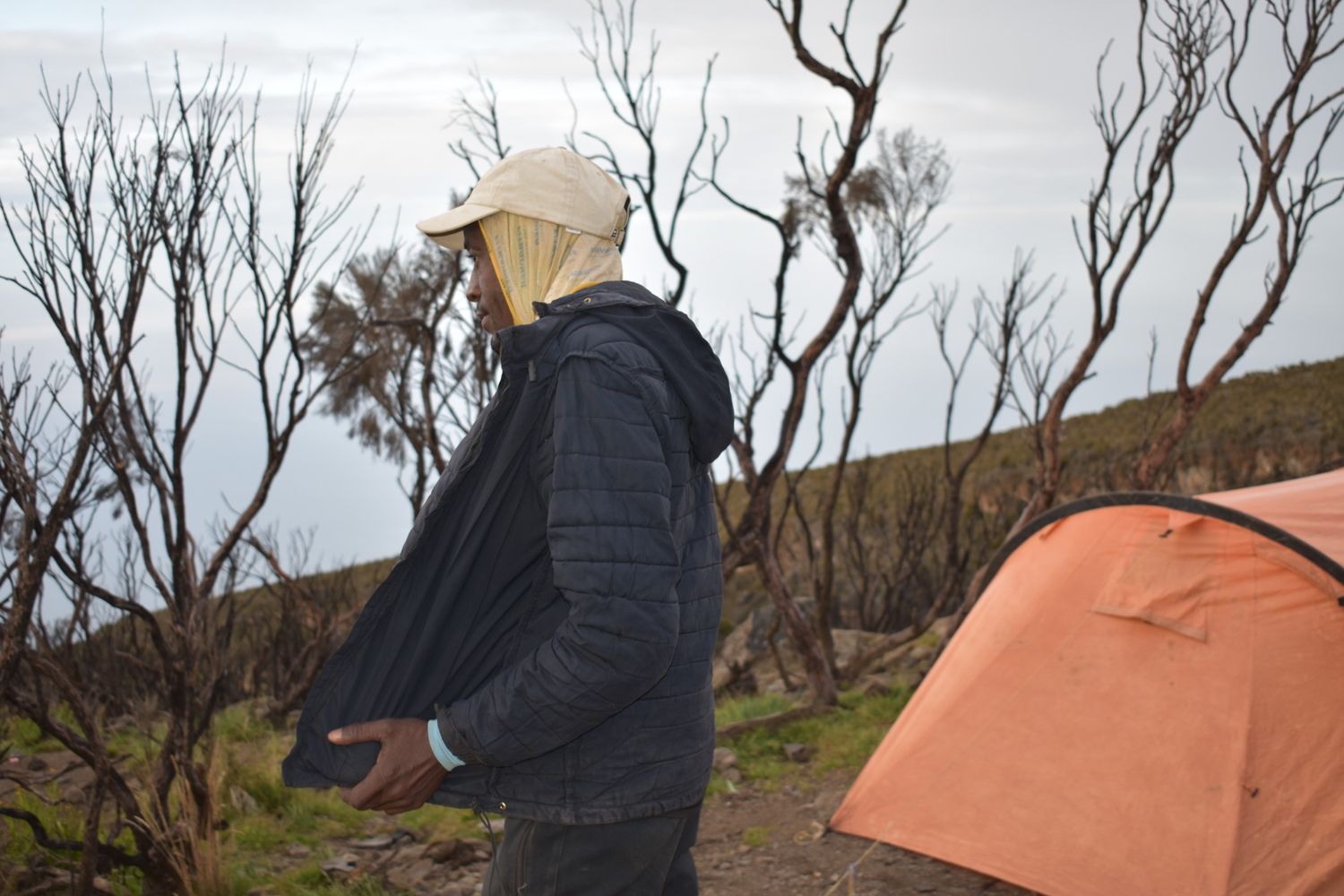
Our guide gearing up as the weather turns on our way out of camp. If you are prepared for the wet weather it is manageable but never ideal.
What is the weather like on Kilimanjaro in April and May?
April and May are usually the wettest months on Kilimanjaro and not ideal for trekking. I recommend avoiding the rainy months of April and May on Kilimanjaro.
What is the weather like on Kilimanjaro in June, July, August and September?
June, July, Augusts and September are the busiest months on Mount Kilimanjaro as they coincide with the European and North American summer holiday period.
Encountering rain or snow in June, July, August and September on Kilimanjaro is rare. As the slopes are busier at this time of the year it is quite easy to find tour companies that offer open groups that you can join to help save on costs.
What is the weather like on Kilimanjaro in October, November and December?
October on Kilimanjaro is a great shoulder month to trek. Weather conditions are good and the slopes less busy. November on Kilimanjaro is a short rainy month.
If you plan to trek this month I recommend the northern approach on the Rongai, which is generally dry. December is a cold month, usually with lots of snow. Trekking is fine if you don't mind the cold.
December on Kilimanjaro allows for a Christmas or New Year summit, which has become popular.
Mount Kilimanjaro Temperature
Kilimanjaro temperature is heavily influenced by changes in altitude. So much so that there are in fact distinct climatic zones on the mountain, each with its own distinct fauna and flora.
Below I briefly discuss the temperature on Kilimanjaro as you trek higher through the different altitudes.
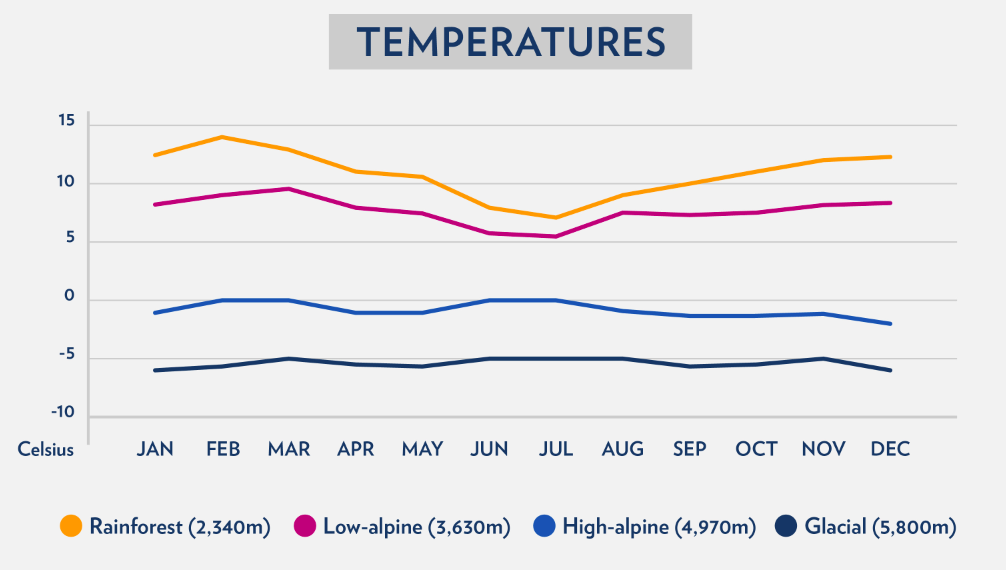
Rain forest zone (~800 meters – 3,000 meters)
From the earliest part of your trek you are going to be confronted with tropical rain forest. Humidity is high and light mist or sometimes drizzle is common.
Various flora such as orchids, ferns, fig and olive trees cover this area of Kilimanjaro.
You will likely see Blue and Colobus monkeys, and if you are trekking from the North-East Rongai route or Western Lemosho, Shira or Northern Circuit you may even see elephant, buffalo and large antelope.
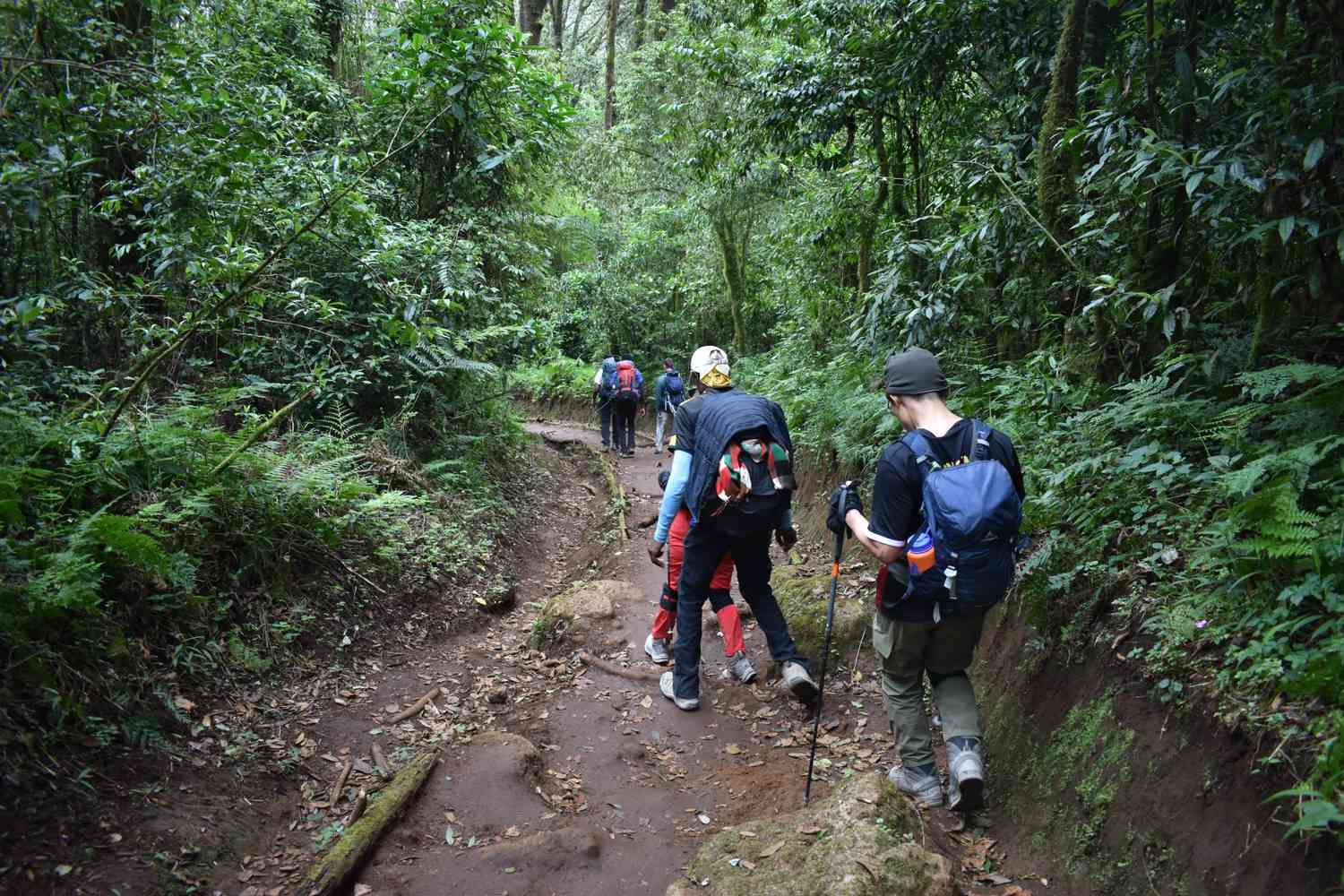
When trekking back down to the gate, light drizzle in the rainforest zone can make the dirt trail slippery.
Low alpine zone (~3,000 meters – 4,200 meters)
At approximately.3,000 metres the rainforest rapidly gives way to semi-arid grasslands and moorlands, this area is known as the low alpine zone.
Heather and small shrubs cover the landscape, the weather is significantly less humid and temperatures can get to sub-zero in the evening.
The most prominent flora features in this zone are the Senecios and Giant Lobelias, which look like deformed palm trees. Fauna is sparse; however you will likely see crows overhead foraging for food.
High alpine zone (~4,200 meters – 5,000 meters)
This zone is characterised by an arid desert environment that is rather inhospitable. During the day temperatures are hot and solar radiation is high (make sure to apply lots of sun-cream).
At night temperatures plummet to below freezing. From this zone the slopes of Kibo and Kilimanjaro’s summit come into perfect view.
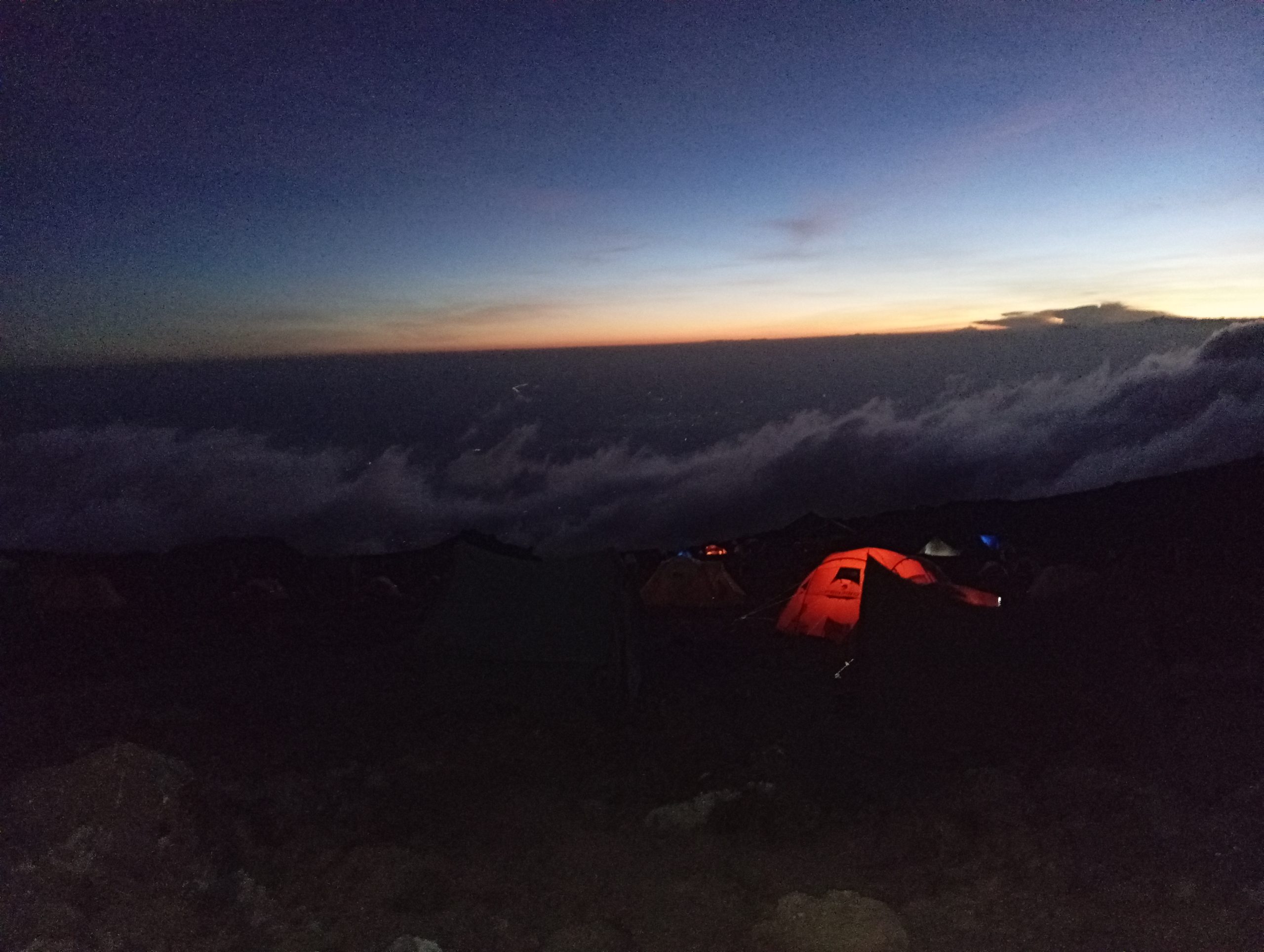
In the higher camps, temperatures are near freezing after dark. Don't forget to pack your thermal base layers!
Glacial zone (~5,000 meters to 5,895 meters)
The final zone houses the upper reaches of Kibo and Mawenzi and consists of high altitude artic conditions.
Life is very scarce in this zone as oxygen levels are near half what they were on the lower reaches of the mountain.
Fine glacial silt covers the slopes that reach up to Kilimanjaro’s summit and large glaciers are visible from Kilimanjaro’s crater rim.
Due to the high solar radiation during the day, freezing temperatures at night, gale force winds and low oxygen levels, this zone is not one where you want to stay too long!
Snow on Kilimanjaro
Snow on Kilimanjaro can occur all year round, but the most common months are November through March. Here is a chart showing average snowfall by month.
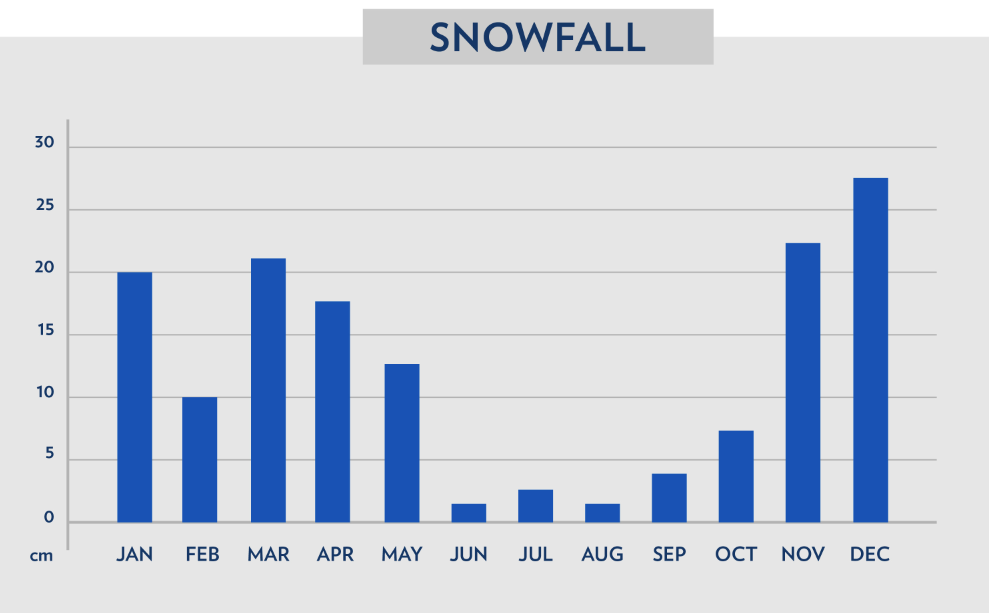
Understanding Mount Kilimanjaro Weather
Kilimanjaro’s weather can best be understood by studying the the dominant trade and anti-trade winds that pass through the region.
Why?
Because winds carry moisture from the ocean. When they hit large objects, like mountains, they rise, cool and condense, forming clouds and precipitation (i.e. rain and snow).
There are two main winds that drive weather patterns on Mount Kilimanjaro – the South-east trade winds and North-east anti-trade winds. I explain the influence of each wind below.
Trade and Anti-Trade Winds

World map showing SE and NE Trade Winds
South-East Trade Winds
The South-East trade winds from the Indian Ocean arrive around mid March and last well into May (before being interrupted by the North-East Anti trade winds).
These winds carry loads of moisture from the Indian ocean so when they eventually hit the massive structure of Mount Kilimanjaro and are forced upwards, they form large rain clouds and the ‘heavens open’.
Mid-March through to the end of May is therefore the wet season on Mount Kilimanjaro and not a great time for trekking.
That being said, as these winds blow from the South most of the rain falls on the southern side of Kilimanjaro.
The Northern slopes tend to be buffeted from the winds and therefore receive considerably less rain during this time of the year.
If one wants to trek in March-May it is best to consider the Rongai Route which follows a trail from the North.
North-East Anti-Trade Winds
Anti-trade winds from the North-East arrive between late May and last through to early November and don’t carry rain as they lose their moisture well before hitting Kilimanjaro.
They generally blow quite strongly forcing their way through the Saddle (the valley between Kilimanjaro’s two peaks – Kibo and Mawenzi).

Cross-section showing Kilimanjaro’s saddle between Kibo and Mawenzi Peak
As the strong anti-trade winds pass through the saddle they force the South-East winds down below them.
Hence during the dry season (June through to October) cloud cover and some rain is common up to the 3,000 meter mark on the southern slopes but quickly disappears above this altitude.
The dynamic between the strong and dry North-east trade-winds and the less powerful South-east winds, means that late May through to the end of October is a great time to trek as rain is rare and usually confined to the lower southern slopes.
May through to October also coincides with the summer holiday periods of the Northern Hemisphere so the slopes of Kilimanjaro can be busy at this time of the year.
North-East Monsoon
The North-East Monsoon arrives around mid November and lasts through to February. These winds have travelled a long way over the continent and don’t have a high moisture content which means that the season is generally quite light on rain.
Most of this rain falls on the lower northern slopes of Mount Kilimanjaro, but is a lot lighter than the main wet season brought by the South-east winds in March-May.
The interaction of these winds with Mount Kilimanjaro mean that there are two main trekking seasons – January-March and June-October.
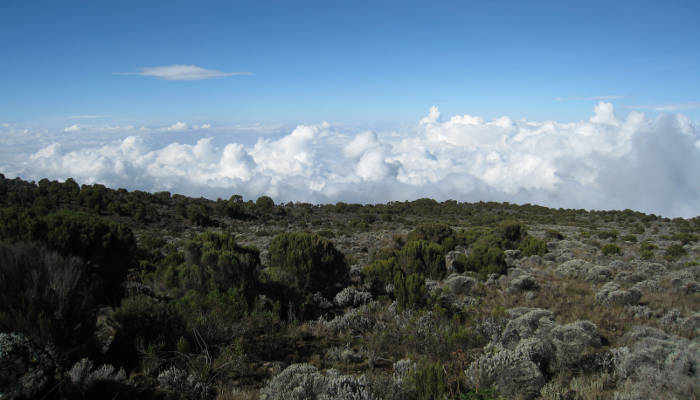
Common cloud cover below 3,000m with crystal blue skies above

Get a Kilimanjaro trek quote
These are the companies I recommend...
Kilimanjaro Weather Forecast
Below is an example 9-day Kilimanjaro weather forecast that you can get access to on www.mountain-forecast.com.
You can also get forecasts from www.snow-forecast.com and the University of Massachusetts have been tracking climate change on Kilimanjaro since 2000. Have a look at their research and weather data here.
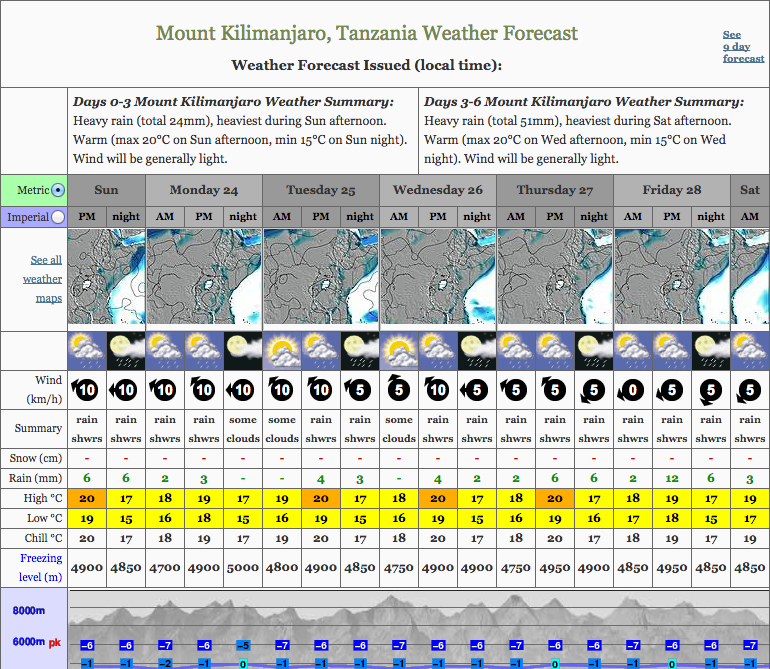
Mount Kilimanjaro Weather FAQ
What is the temperature at the top of Mount Kilimanjaro?
The temperature at the summit of Mount Kilimanjaro can range from 0 to -20 degrees Celsius (32 to -4 degrees Fahrenheit).
A big factor that drives the temperature at the top of Mount Kilimanjaro is the wind.
The wind chill factor can make a relatively cold night, like -2 degrees Celsius (28 degrees Fahrenheit), feel like -15 degrees Celsius (5 degrees Fahrenheit).
It's worth noting that temperatures at the summit are colder at night, which is the time that most trekkers push for the summit. By late morning it can actually feel quite hot at the summit, especially on a windless clear day.
Which are the wettest months on Kilimanjaro?
The wettest months on Kilimanjaro are April and May. These are not good months to hike the mountain. Later March can also see quite a lot of rain.
There is a short rainy season in November as well. The Northern side of Kilimanjaro is in a rain shadow, so if you're limited to these months, then try the Rongai route.

Plan your Kilimanjaro trek
Get a quote from my recommended local Kilimanjaro operator
My Final Thoughts
And there you have it: Everything you need to know about Kilimanjaro weather. When are you going to conquer this African giant? Let me know in the comments below.
More of my Kilimanjaro Guides:

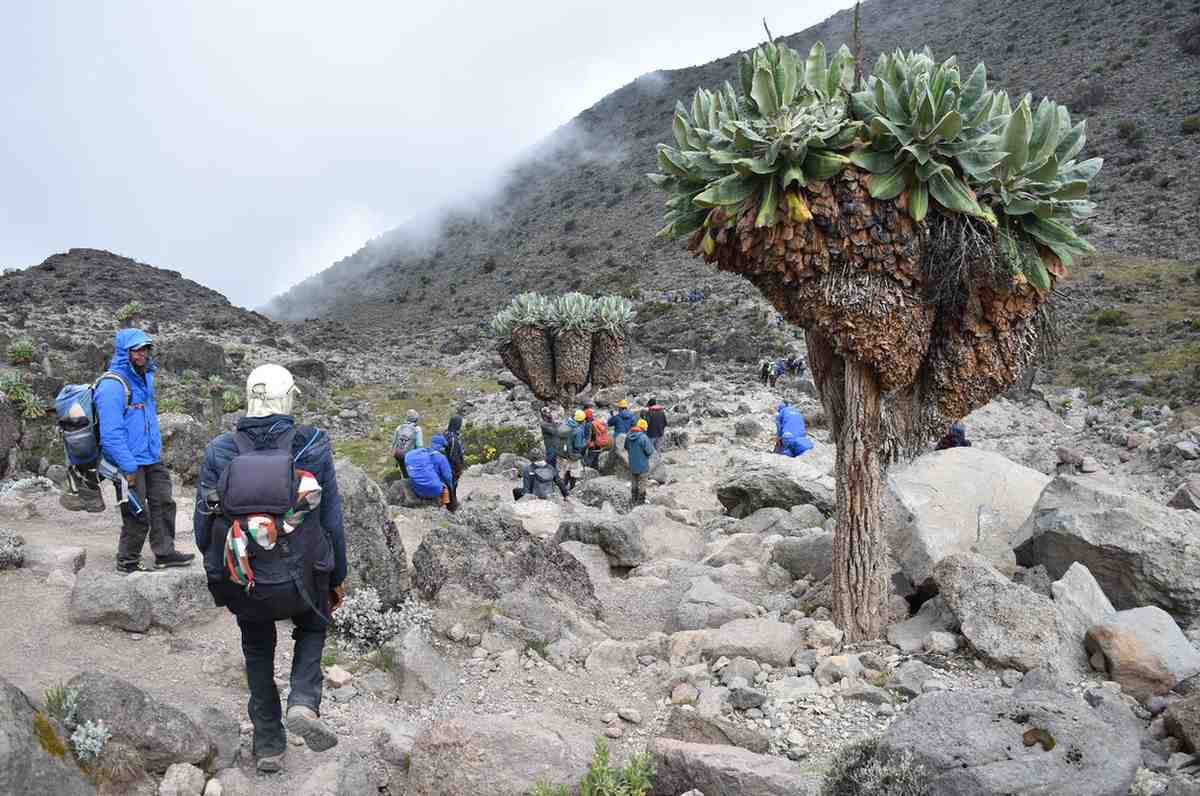
I understand that September/October transition is still dry, but what it would be the chance of encountering snow at the summit during this period? Planning approach from the northern.
Thanks
Hi Edgard, it’s possible to encounter snow at the summit throughout the year, but the probability in September and October is quite low.
In the movie Inconvienent Truth, Al Gore said “In the next decade, there will be NO MORE SNOW on Mt. Kilamanjaro.
That appears to be false.
Am I wrong?
Hi Doug, yes and no, a lot of snow still falls on Kilimanjaro, but the glaciers have all receded in the past 100 years. Many have disappeared completely.
Hello, I am planning to trek kili in august. How will the temperature be at the summit? Will it be cold during the day time when we hike on the rest of the days?
Thanks!
Hi Soms, August is a good time to trek Kilimanjaro. Temperatures on the summit though can get very cold (sub zero Celcius), and if the wind is blowing the chill factor can be nippy too. Make sure to bring warm layered clothing (see here: https://www.climbkilimanjaroguide.com/kilimanjaro-kit-list/kilimanjaro-clothing/). As for the preceding days these can vary in temperature by altitude – the article above explains this in detail.
Hi Mark,
I’m climbing up 7 day Machame on 5th November with my boyfriend and relatively fit parents (who’ve never camped before!) so this will be all sorts of challenging for us, but I bet we’ll be fine!
I’m trying to work out if daytime temperatures are hot that time of year, and if so on which days or should we be wearing full sleeve merino tops from day 1. Expecting night time temp to be -20ish so will be prepared for super cold nights, just not clear that the days will be like. Any comments? Thanks!
Hi Pad, the day temperatures on Kilimanjaro, assuming a clear day and little wind, are generally comfortable (trekking shirt and maybe a gilet or light fleece). As you get above the clouds it can be a little cooler during the day, so you may wear a base layer as well. And above 4,000m it can be quite cold so it is possible you might layer up with a down jacket. Weather is variable during the day so some periods can be quite hot, whilst others can be quite nippy. The trick is to have layers, so you can layer up and down as necessary. Best of Luck!
Hi, I tackled Kili via the Machame route in August this year and was defeated by altitude sickness at Lava Tower (pulmonary oedema, oxygen 63%) I want to try again, but taking the slower, Northern route. Is February a good time? I realise I might not summit, but could at least try!
Hi Hilary, sorry to hear that the altitude got the better of you, but nice to hear you want to have another go. February is a fine time to climb. The Northern Circuit also offers better acclimatisation, although you still need to get over the Lava Tower / Moir Hut challenge early on in the trek. If you can get over this segment then I would say you stand a good chance of properly acclimatising and summiting. All the best!
Hi Mark,
I am considering climbing Kilimanjaro on Dec 14-20 or the first week of Jan. Do you think the later is much better than former in terms of weather? Thanks!
Hi Frederick, weather conditions around December and January are very similar so I don’t think it would make much difference whichever date you chose. Of course weather can vary dramatically week to week so you may get a great week or a week with more inclement weather. This is hard to predict. Generally December and January is dry, but cold high up the mountain with snow cover very likely.
We’ll be trekking Kilimanjaro from July 31st to Aug 5th. What weather can I expect during the climb.
Hi what would be the temperature difference for the last day climb between first week of January and any week in July?
Hi Marianne, temperatures can vary considerably so it’s difficult to predict. Generally, the month of January is colder with higher probability of snow at the summit compared to July, but the temperature variation can fluctuate and is heavily influenced by the wind chill factor. On average it is probably a few degrees warmer in July, but still cold enough to mean proper winter layers are required.
Thanks for the detailed article. I will be climbing the Lemosho route starting May 18. I am thinking of taking microspikes for snow and mud. What are your thoughts?
Hi Stephanie, it’s unlikely that you will need microspikes as heavy snow is quite rare in May. But there is no harm in taking them.
Mark, sleeping at night – once out of the rainforest – I’ve seen a recommendation for a -10C sleeping bag. Thats about 15F and sounds like a sleeping bag that covers that temp would be fine. Any other recommendations? Cheers!
Hi Clay, yes, a sleeping bag with that type of rating would be fine. Cheers!
Que mes es mas calido y memos posibilidad de lluvia. Gracias
June-October are the warmer months with the lowest possibility of rain. All the best!
Dear,
I’m planned to hike up Kilimanjaro in two weeks (six days starting on the 30th of jan 2018). What can we expect ? We will be taking the Marangu route.
Thanks in advance !
Stephan
In terms of the forecast next week, check out: https://www.mountain-forecast.com/peaks/Mount-Kilimanjaro/forecasts/5963
We are planning on climbing Kilimanjaro in the last week in January (at the Summit on January 30th). We see all the snowfall. How much snow is there at the top? how much snow can we expect when we summit?
Thanks Dov
We are thinking of hiking Mount Kilimanjaro the 2nd half of December’17 with a night stay at the Crater Camp. Any advice? What is the weather forecast at the Uhuru Peak for that period? Thanks in advance?
Hi Saeed, It is very difficult predict what the weather will be like so far in advance, but it is likely that there will be quite a bit of snow on Uhuru Peak and in the Crater. You can find a 7-day forecast here: https://www.mountain-forecast.com/peaks/Mount-Kilimanjaro/forecasts/2000
What is the nighttemperature at the camp in 4500 m and at 5900m at Kilimanjaro in february?
I’m gonna try to reach the top 13/2 2018.
Best regards Jens
Hi Jens, Temperature can fluctuate alot, but you can expect sub zero temperatures at night when you get over 4,500m. The summit to push is during the early hours of the morning so prepare for sub zero temperatures. Depending on the wind chill factor it can get as cold at -10 degrees Celcius. Make sure you layer up! https://www.climbkilimanjaroguide.com/kilimanjaro-kit-list/kilimanjaro-clothing/
Hi there, just wondering what temperatures to expect thru day and night. We are booked in to do Lemosho 8 days starting July 15 th
Hi Marie, Temperatures vary considerable with altitude and between night and day. Check out this article for detailed information: https://www.climbkilimanjaroguide.com/best-time-to-climb-kilimanjaro/
Sadly I am not in a physical condition to climb Kilimanjaro but I would very much like to get a view of the mountain from Moshi. What is the best time of the year to get this opportunity? Also, is there a good time to get a view of the mountain from the north? Amboseli? or Loitokitok?
Hi Ray, its hard to guarantee good views of Kilimanjaro from Moshi but on average there is less cloud cover during the Summer months (June-October). Views from the North tend to be clearer and better!
What about September weather, do you recommend hiking in this month?
Hi Hamed, yes, September is a great month to climb Kilimanjaro.
Hello! We are planning on climbing the Machame route May 26 -June 2. Should I plan on a lot of rain? And how cold will it be? People keep talking about it being cold, but I live in Utah, in the US and to me “cold” is relative? I want to be prepared though! Please let me know! Thank you!
Hi Erin, the end of May can see some rain on the lower reaches of the mountain but you might get lucky. As a precaution make sure to bring good wet weather gear. In terms of temperature generally you can expect low negative single digits in the evenings and early morning. On summit night the temperatures can drop as low as -20 degrees Celcius if there is a lot of wind. The sustained exposure to the cold along with the high altitude means that cold weather is a factor and you should have the right gear to layer up or down as conditions change. See here: https://www.climbkilimanjaroguide.com/kilimanjaro-kit-list/kilimanjaro-clothing/
Thank you SO much!!!
Hi,
We are planning on honeymooning on Kilimanjaro. I know, she’s amazing, right? We are planning on going May 16-21, 2017 and I would prefer a route with less rain, like Rongai, but I hear Machame is very scenic. She wouldn’t hate me forever if there was a little rain but I would want to make sure our entire trip isn’t soaking wet.
Thanks!
Hi, nice honeymoon idea, I’m sure your wife will have a blast! I would suggest sticking to the Rongai route as mid may can be quite wet and unpleasant on the Southern Routes, like the Machame. Of course you could get a great week of weather but you have a higher probability of experiencing rainfall on the Machame in mid May than on the Rongai. Hope you guys have a great trip!
Hello,
Do you think the 19-26th of march is still great to climb Mount Kilimandjaro or is it too risky?
We have read several think, some people say it’s already the rain season, some other says it’s perfect because there are not much people and the weather is still very good,
Thank you for your support
Hi Stephane, I have climbed in late March and it was absolutely fine. We experienced some rain on the lower reaches but not too bad. In general you should be fine, but you might get a rainy day or two. All the best!
Thoughts on climbing the last week of May possibly? Thoughts on weather?
Hi Travis, last week of May can be touch and go, but in general you should be fine. Just be prepared to experience some rain on the lower reaches! Cheers!
Hi, we are hiking in Lemosho route from in Feb 2nd week. I see on Mountain Forecast lot of snow fall in the next week. Where exactly will that snow fall be? I see many inches (some times up to a foot of snow predicted). Will it be possible/safe to hike?
Thanks in advance.
Most snow falls at the summit or near the top of the mountain. Generally it is safe to ascend Kilimanjaro when it is snowing.
What would be the best time and best route to climb in February or March 2017?
I recommend the 7-day Machame or 8-day Lemosho. All the best!
Hi, I’m planning on climbing Kilimanjaro from December 5th-12th. what should I expect in terms of the cold and rain?
How do you suggest that I ensure I stay dry and warm? I have a cover for my day pack. Should I get one for my North Face Duffel that the porters will carry?
Do you recommend getting mid-weight tee shirts and mid-weight long sleeve shirts instead of the usual lightweight?
Hi Sarah, Check out http://www.mountain-forecast.com/peaks/Mount-Kilimanjaro/forecasts/2000 to get historical forecast of Kilimanjaro Weather by altitude. Yes, a rain cover for your daypack is a good idea. In terms of your duffle the porters usually have waterproof carry sacks so you should be good here. I would keep your gear separated in transparent plastic bags just in case, and it’s a great way to separate dirty / wet clothes. I prefer light-weight shirts and mid-weight fleeces. Cheers!
Hi I would like to know daily day temperatures and night temperatures expected in Jan 2017 for the Lemosho route. Also, should we expect rain ? if yes how much ?
Hi
We are climbing kilimanjaro from dec 10 to dec 18. Expecting to summit on dec 17. What should we expect the weather to be like and given that this is likely to be the coldest month, should we expect snow on the summit and thus bring our crampons along?
Hi Andrea, Check out http://www.mountain-forecast.com/peaks/Mount-Kilimanjaro/forecasts/2000 to get historical forecast of Kilimanjaro Weather by altitude. You will most likely not need crampons, but you may want to take yaktraxs. All the best!
Hello
We are climbing Kili by Machame route during the last week of December. What kind of temperatures can we expect? Thanks
Hi Andrea, Check out http://www.mountain-forecast.com/peaks/Mount-Kilimanjaro/forecasts/2000 to get historical forecast of Kilimanjaro Weather by altitude. All the best!
Hello. We are planning to climb kili from Machame route between nov 26 and dec 3rd. What will the weather be like and what type of additional equipment we should consider
Hi Carla, It is very difficult to predict the weather on Kilimanjaro, but in general late November can be characterised by light rains on the lower reaches and colder conditions near the summit. Therefore I would definitely take good wet weather gear as a precaution and make sure you have lots of warm layers for summit night. Check out http://www.mountain-forecast.com/peaks/Mount-Kilimanjaro/forecasts/2000 for a more accurate snapshot of the weather just before you leave. Cheers!
Hi, we will be at Machare Estate – coffee farm from the 30/10 – 06/11/2016,
can you please let us know what temperature will be (more less).
Thanking you in advance.
Go here: http://www.mountain-forecast.com/peaks/Mount-Kilimanjaro/forecasts/5963 and select altitude 2,000m to get a forecast for your dates. Cheers!
Hi, I am starting to plan my trip to Kili. Being a teacher, I need to go in June or July. What is your recommendation on dates and routes for this time frame?
Hi Ursula, June / July are good months to trek Kilimanjaro. I would recommend the 8-day Lemosho or the 7-day Machame. All the best!
Hi,
I am looking to climb Kilimanjaro with friends November 10th – 20th. What will the weather be like around this time and which routes would you suggest?
Thanks
Hi Saleh, November is the short rainy season on Kilimanjaro. You can expect some rain on the lower reaches of the mountain and potentially snow on the summit. The Rongai route is generally good for the rainy seasons but in November the northern side of Kili is also prone to getting rain. I would suggest either the Rongai or the Machame.
Hi We are climbing Kili from 12th Sept what is the weather forecast??/
Hi Gita, You can find forecast information for Kilimanjaro here: http://www.mountain-forecast.com/peaks/Mount-Kilimanjaro/forecasts/2000
Hi, I am looking to climb Kilimanjaro with a friend November 29th – December 8th. What will the weather be like around this time and which routes would you suggest?
Hi Matthew, this is at the end of the short rainy season so you might experience some rain on the lower reaches of the mountain. December through February is also the coldest time of the year near the summit so it is not uncommon to experience snowfall at the summit and perhaps a heavy layer of snow there too. I would suggest the Rongai route for this time of year as the Northern side of Kilimanjaro is drier than the southern routes. Hope this helps!
Hi. I have plan to climb Kilimanjaro from 9th sept to 15th 2016. What kind of weather i can expect? Which is the best route? Am alone so can I join with group?
Hi Vinod, The weather is September is generally very good, with low probably of rain and snow. I recommend the 7 day Machame or 8 day Lemosho as the best routes to climb Kilimanjaro. To join a group visit our recommendation service here: https://www.climbkilimanjaroguide.com/go/
Hi. We plan to climb Kilimanjaro via machame route from 9th Oct to 15th Oct 2016. What kind of weather we can expect?
Hi Pragnesh, the weather in October is generally good. See our detailed article here: https://www.climbkilimanjaroguide.com/best-time-to-climb-kilimanjaro/
Hi , We are Planning to climb Mt. Kilimanjero during the first week of November, 1st to 7th.
What is the weather going to be like ??
Thanks.
Seema.
Hi Seema, forecasting weather on Kilimanjaro is tough due to the altitude variation from the foothills to the summit. Generally November is a wettish month but you could get a great week of weather.